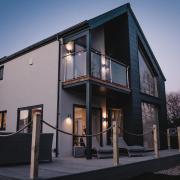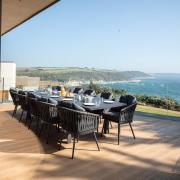In this June issue, Cornwall Life looks at the health benefits of a hot tub
Hot Tubs for Health
In this June issue, Cornwall Life looks at the health benefits of a hot tub
Few other additions to your garden are likely to bring such a profound sense of well-being for you and the whole family than a garden spa or hot tub. You can enjoy considerable health benefits of a massage therapy hot tub all year round.
A hot tub offers the ideal antidote to the hectic pace of modern living. The moment you slip into a hot tub you instantly lose 90% of your body weight as you float in the water. Immersing in hot water causes your blood to rush to your skin. It is warmed before penetrating deeper into the tissue below the skin, bringing more oxygen, cleansing carbon dioxide and relaxing your muscles.
The hot water increases blood flow and stimulates the production of endorphins - the body's natural opiate and painkiller - giving a natural feeling of well-being. The combination of warmth and buoyancy makes the hot tub an ideal form of hydrotherapy for people suffering from conditions such as arthritis or those recovering from orthopaedic surgery, such as a hip or knee replacement. The spa can also reduce blood pressure and improve circulation and there is even research that claims the massaging waters can help reduce cellulite.
Other research suggests that soaking in a hot tub before bed can ease the transition into a deeper sleep, and a recent American report claims a daily spa session can be beneficial for people with Type 2 diabetes.
When hot, pulsing water stimulates nerve impulses; your body's reflex arcs transmit the sensation to other parts of your body. This is not too unlike the effects of acupuncture, in which stimulation at one point produces a response elsewhere.
If you are looking for the ultimate cold remedy then think hot tub. Immersing in hot water enlarges blood vessels, helping to unclog nasal passages and increasing body temperature and the number of virus- and bacteria-fighting white blood cells three-fold, which means it is helping your body fight those toxins it doesn't need.
When choosing a hot tub, compare features such as pump power, jet configuration and seating combinations. Look out for lighting and water feature effects as well as aromatherapy options. Some top-end models, known as 'swimspas', offer aquatic exercise workouts such as underwater rowing and jogging or on-the-spot swimming against a fast-running current of water. Other extras include sound systems and even TV and DVD options are readily available.
Running costs, per day, on insulated tubs will range between approximately 30p and �2 depending on the features. A bit like test-driving a mattress for your bed, you should always take the opportunity to 'wet test' your hot tub before taking the plunge. Make sure it is deep enough for the tallest members of the family and not too deep for the shorter ones.
Tiered seating makes the hot tub suitable for all ages and physical abilities. With good local dealers you can be sure that you will be able to obtain good service, water treatment products and quality parts all year round.
Maintaining your hot tub need not take more then three minutes a week. It is vital to use a sanitiser such as chlorine or bromine, as the water will quickly become bacterial otherwise. It really is as easy as using dipstick-style test strips to test your sanitiser levels and pH levels. It takes just a few moments to check the levels before enjoying the tub.
When the levels need adjusting you use one scoop (approximately 40g) to adjust the levels, per square, on the test strips using the appropriate water treatment product. There are also products to restore clarity to water, reduce stain and scale build-up.
Filtration is one of the most important aspects of a hot tub. Like a flowing river, your tub's filtration aids water health and prevents the water from ever going stagnant, even when you're away on holiday.
Hot tub shells are available in a variety of colours and finishes to meet your individual tastes. Originally people used to sink their hot tubs, but today they are extremely durable and weather-resistant, and designed to withstand all weather conditions. Made from acrylic reinforced with fibreglass, home hot tubs come complete with heating and filtration built in, and are very straightforward to install by a qualified electrician to a 30 amp supply.
Jets can massage your feet, ease your aches and pains, and simply relax away the stress of a long day. Whirlpool jets move water in a circular motion to loosen tight muscles, especially in the neck and shoulders. Swirling jets can target certain areas of the body, while pulsating or gattling jets flush water in staccato successions over a larger radius (great for the lower back if lying on a lounger). Hand and foot jets are designed specifically to relieve these overworked muscles.
Do you prefer to enjoy your hot tub experience lying down on a lounger or immersed in a chair, or would you prefer to cuddle up in a two-person love seat? Perhaps the ideal solution would be a combination of seating options so that your hot tub can accommodate everyone in the family, from youngsters to grandparents.
Enjoying your own hot tub at home could not be easier. Your local spa specialist store should be on hand to answer all your questions. Once you've made the decision to buy a hot tub, the next step is to decide where to put it. A private place, yes, but perhaps not right at the bottom of the garden. Try and pick a secluded, sheltered area reasonably near to the house. Ideally not under a tree, as you may end up with a tub full of leaves. A good path or walkway to the spa is definitely a good idea.
For advice and further information contact the British and Irish Spa and Hot Tub Association (BISHTA) on 01264 356211 or visit www.bishta.co.uk


























